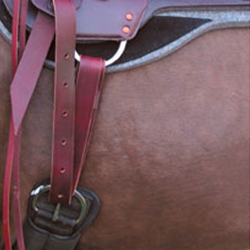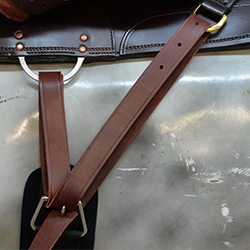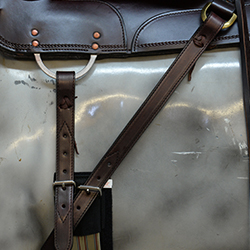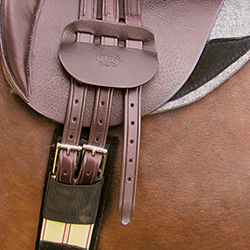Your Complete Guide to Saddle Rigging
Your complete guide to saddle rigging
Rigging {ˈriɡiNG} : v. Used to refer to how the cinch strap attaches to the saddle to hold the saddle in place.
Rigging basics
Hardware: The rigging hardware can be D rings, circular rings, or a flat plate. A saddle can also have a combination of two of these. Most of our saddles have high-quality stainless steel, brass, or bronze hardware that will not rust or flake.
Type: Rigging can be grouped into two types: conventional on-tree rigging and in skirt rigging. Conventional rigging places the bulk of the cinch strap under the rider's leg. Inskirt rigging has proven itself to be just as secure as conventional rigging. In this style, the rigging hardware is built directly onto the saddle skirt, either built directly on the skirt or for extra security, built "in" the skirt, where the rigging is attached to an extra metal plate between two layers of leather on the skirt.
Single or Double: Single rigging does not involve the use of a flank strap. Instead, the rigging hugs the saddle toward a center point. Double rigging includes both the cinch and flank strap. Double rigging is especially necessary when roping or other activities like steep trail riding which may cause the saddle to want to tip upwards.
Position: The position of the rigging largely depends upon the purpose of the saddle. 3-way rigging allows you the option of choosing a full double rig, 7/8 double rig, or 3/4 double rig. Rigging that sits directly under the midpoint of the saddle is termed "centerfire" rigging, and each position toward the horn is given a different fraction: 5/8, 3/4, or 7/8. Note that Full and often 7/8 rigging requires a back cinch to keep the saddle from tipping forward in certain riding environments.
Rigging by discipline
The type of rigging a saddle has is related to the purpose of the saddle depending upon the amount of stability the activity requires.
- Most trail saddles come in 7/8 position rigging or 3 way rigging, which allows you to choose between full, 7/8, or 3/4 position. Most casual trail riders use 7/8 single rigging. However, if the trail has steep downhill and uphill slopes, we recommend adding a flank strap to keep the saddle from tipping.
- Endurance saddles are usually equipped with center fire or 5/8 position. The 7/8 rigging that is on most trail saddles won't work for endurance riding -- endurance horses need the full range of their elbows, without a cinch too near them. Western saddle rigging tends to pull straight down, putting more pressure in the front of the saddle, but the rigging on endurance saddles should pull more from the center of the seat. Quality endurance saddles will have a rigging system that avoids bulk under the rider's leg, eliminating chafing and irritation. Remember that center fire rigging requires a rather wide cinch (6-8 inches) to keep everything in place.
- Ranch saddles are also known as "all around" saddles and are meant to be multi-purpose, suited to both full work days and long rides, keeping you and the horse comfortable for long stretches of time. They are usually double rigged for more stability.
- Because the discipline of reining is also meant to show off a horse's conformation and precision, reining saddles usually feature a low seat, free swinging fenders, and thinner stirrup leathers. Reining saddles are usually equipped to be double rigged, but professionals rarely use a flank cinch and the rigging is dropped to reduce bulk under the rider's legs.
- For more rigorous disciplines such as roping and cutting, full double rigging is more appropriate. Without a flank cinch, the pressure of roping will easily cause the saddle to top forward and pinch the horse's shoulders. A flank cinch will keep the saddle securely in place. Inskirt rigging is less common in these heavy-duty saddles because of the stress of the activity.
Pros and cons of different types
One of the most controversial topics in saddle making today is whether in-skirt rigging is as strong as conventional on-the-tree rigging. Saddle makers go back and forth on this topic. You will rarely find a roping or cutting saddle with in-skirt rigging. However, in-skirt rigging has great benefits for other disciplines if it is built well. It eliminates the bulk of the rigging from under the rider's leg, giving closer contact.
According to Reinsman, in-skirt rigging can be as strong as a D rig, and also gives you more surface area to grip the horse's back. Inskirt rigging does not require the cinch to be as tight as a conventional rig. Dale Martin recommends in-skirt rigging especially for barrel, reiner, show, and pleasure saddles because of this.
Flat plate rigging is a compromise between the two of these. Layers of leather are wrapped around a flat plate and riveted to the skirt. An advantage of the flat plate style is that it creates less bulk and does to interfere with the swing of the stirrups.
Another advantage of conventional rigging is that it can be easily replaced and repaired as the saddle wears out. In-skirt rigging, however, requires the entire skirt of the saddle to be repaired and possibly replaced.

Frequently asked questions
Q: My horse has high withers (low withers, a flat back, etc). Is there a superior type of rigging?
A: Generally, no. The rigging of the saddle has little to do with how the saddle fits over your horse's back. The gullet width and angle of the bars of the saddle are the most important aspect of saddle fitting. The most important part of rigging is making sure your cinch strap is properly placed and dies not interfere with your horse's shoulder. A saddle in the 7/8 position will fit over 80% of horses, and unless your horse is very unusually shaped, you should expect the 7/8 position to be fine. 3-way rigging will allow you to select a full or 3/4 position as well.
If you have a horse with a flat, broad back you may want to consider in-skirt rigging because of the extra surface area it gives for the rigging to grip.
Q: How do I tell what kind of rigging is on my saddle?
A: Lift up the fender. It's easy to tell if your rigging is conventional or in-skirt by looking at the rear dee. Is the dee attached between the skirts or sandwiched in the skirt? You can use the diagram above to tell which position your saddle is in. Remember, though, that over 80% of saddles, especially trail saddles, use the 7/8ths position.
Tucker Rigging Styles
Click here to view all Tucker Adjustable Position Rigging Options
Most Tucker saddles come with four choices of rigging styles. Because Tucker uses different terminology than what you read about above, customers often have questions when choosing which style.
Western double-dee dropIf you're used to riding western and like western rigging, go with this style. This style is conventional Western rigging with tie strap and off billets, but sits lower on the horse for less bulk under the rider's leg and closer contact with the horse. |
 |
Enduro-balanced single tieThis style has a conventional front dee attachment with extra "front to back" straps on either side forming a Y on the saddle with the front dee in the middle. This is like using a rear flank strap. The front to back straps create an extra snug fit and make steep riding more secure. |
 |
Enduro-balanced double tieThis type requires an english-style girth. Two separate billets attach to the girth--one attaches to the D ring and one to the back of the saddle. |
 |
Balanced ride english billetThis rigging has three one-inch wide billets which attach to an English girth. |
 |